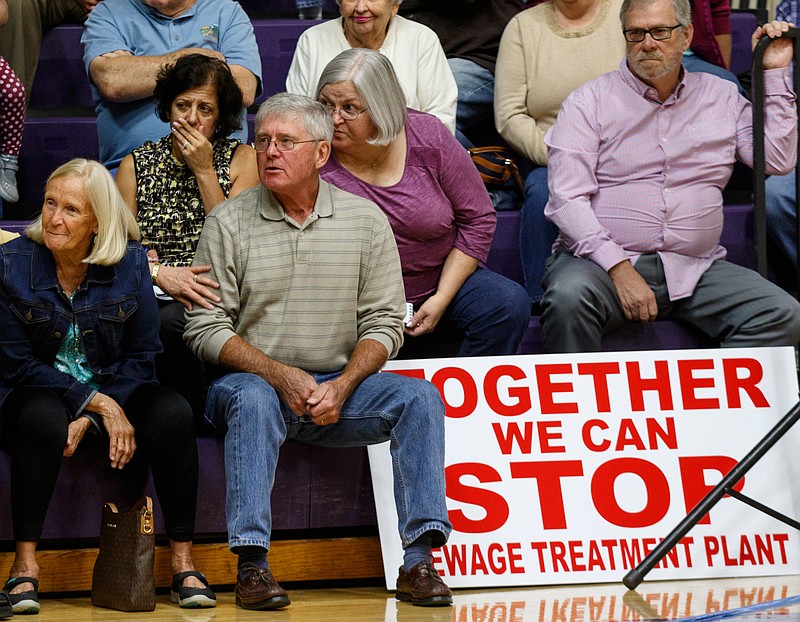It seems there's some funny math involved with Hamilton County's proposed new wastewater treatment plant - wherever it might eventually be located.
Not that this point was in any way mentioned earlier this month as Hamilton County commissioners voted 6-3 against allowing the sewage treatment plant to be built on Mahan Gap Road in the Ooltewah community of the county's northeast side.
Rather, the commissioners voting no - Chip Baker, Chester Bankston, Randy Fairbanks, Katherlyn Geter, Warren Mackey and Chairwoman Sabrena Smedley -largely appeared to be swayed by the community's "not in my backyard" protest.
Once the vote was made and the packed commission room erupted in cheers and clapping, county Mayor Jim Coppinger set the table for the next choice, which he hinted might be still more expensive for us county taxpayers.
You will recall that on Sept. 6, 2017, the commission passed a property tax increase, on a vote of 8-1, in part to pay for a new sewage treatment plant.
Specifically, the readjusted tax rate was to bring in an extra $25.5 million a year, allowing the county to borrow money for a $45 million new wastewater treatment facility, $100 million in school construction and repairs, and $20 million to $30 million to expand Silverdale Correctional Facility.
Fast-forward to now and the many 2018 pitches by county officials and Hamilton County Water and Wastewater Treatment Authority Executive Director Mark Harrison about WWTA's proposed sewage treatment plant. It's needed because EPA is forcing the county's hand to stop and clean up Clean Water Act violations. Without the fixes, Hamilton County cannot continue to grow with new businesses and homes.
In the sales talks, WWTA made two things quite clear: Ratepayers will pay higher sewage treatment fees. And the WWTA will use those higher fees to pay the county's debt service for the $45 million bond. But wait, isn't that what part of our increased tax dollars are paying, as well? We taxpayers are footing the bill for the same plant that ratepayers will pay more for so that the WWTA can pay back the county.
If you're scratching your head, you're not alone. Coppinger argues that the county is not double-dipping (our word, not his). He maintains that it is more like a down payment on tomorrow's better infrastructure - and he says perhaps a future county commission will thereby be able to lower property taxes.
That may be a fair explanation, but it's not the one county taxpayers and WWTA ratepayers have been given. We also think the county and WWTA owe us a much better understanding of why they are playing a shell game about whether we even need a new plant. Perhaps all we need is county and city officials who can talk to each other about carrying out the mission WWTA was created to follow in the first place - fix and extend lines throughout the county to connect to the Moccasin Bend sewage treatment plant.
On the WWTA's web page of FAQs about the proposed plant is a question asking why WWTA can't just pump the wastewater to the Moccasin Bend facility. Answer: "The Moccasin Bend plant is presently operating at maximum capacity and the WWTA has already reached our current capacity that was recently negotiated with the City of Chattanooga. If a new agreement was in place with the City of Chattanooga, and they had available capacity, the WWTA would have to pump the wastewater approximately 40 miles due to terrain and availability of easements. Pumping such distances increases the risk of failures [spills] and is very costly."
Most of that is bunk. Moccasin Bend is not - repeat, not - operating at capacity, according to city officials and Coppinger. The city's plant has a treatment capacity of 140 million gallons per day. It now treats, on average, 65 million gallons a day - leaving plenty of room for the 10 million to 20 million gallons a day the proposed Mahan Gap facility would have handled. During wet-weather events, the city can pump an additional 90 million gallons a day through its wet weather storage system, creating a total wet weather capacity of 230 million gallons a day.
Also, please take note of WWTA's phrase, "If a new agreement was in place "
An April 2007 Times Free Press story shows such agreements have been batted around for years: "Since its creation in 1994, the Hamilton County Water and Wastewater Treatment Authority has grown to serve all the county's unincorporated areas and all its municipalities except for two: Collegedale and Chattanooga. County Commission Chairman Larry Henry and treatment authority Chairman Henry Hoss said the county would be served best by complete consolidation."
They wanted Collegedale and Chattanooga to join the WWTA. But who would control that consolidation was the sticking point. Then-Chattanooga Mayor Ron Littlefield basically said no thanks, but maybe in the future - along with other "metro service" ideas.
No one wants to pay more taxes, let alone higher taxes. Yet having a great community to live in is not free. We're not saying our 2017 tax increase shouldn't have happened, nor are we saying another increase might not be needed. There are no free lunches or free schools, and sewage won't go away by itself.
But we don't like feeling as though we're being played for chumps so the county can get an extra bang for its tax buck.
